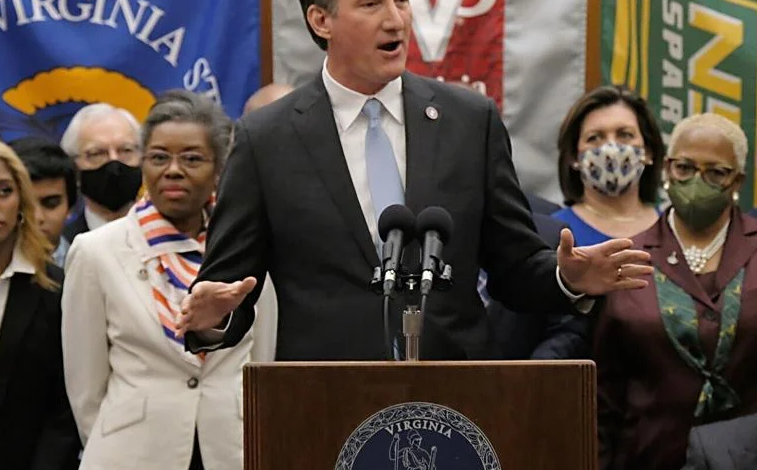Virginia is overhauling its way of launching regulations

For at least 70 years, Virginia politicians have accepted the notion that some issues are better handled by state agencies than by the courts or General Assembly – and they’ve been arguing ever since about exactly how much.
Now, Gov. Glenn Youngkin aims to have a tool to meet his goal of cutting the state’s regulatory requirements by 25%. It is the goal of the first major overhaul in more than 25 years of the way Virginia governors review new regulations and revisions to existing ones.
It’s a target that’s not new – the General Assembly in 2018 launched a pilot program to do just that, to test the waters for a general cutback. It passed unanimously.
The sponsor, Del. Michael Webert, R-Fauquier, calling the 2018 bill one of his favorite pieces of legislation to have worked on, said support for easing regulatory burdens has support from both sides of the partisan divide.
He found that as he tried to build on the program and create a continuous regulatory program with two-year reduction goals during the latest legislative session, efforts failed in the Senate. The measure won 11 Democratic votes in the House of Delegates and support from five of eight Democrats in the Senate General Laws Committee but died in a party-line vote in the Senate Finance Committee.
“It came out [of] the House with some Democrats’ support,” he said. “I think if we’d been in a different time era, it might have gotten out with even more support and got through the Senate.”
Del. Schuyler VanValkenburg, D-Henrico, who co-sponsored the 2018 pilot legislation, said: “We should want regulations when they make people’s lives better. And when they’re inhibiting people’s lives or they’re inhibiting government working effectively, we should either revise them or do away with them.”
Calling it a compromise that “hit the sweet spot,” VanValkenburg noted that he is wary of regulatory trimming that is arbitrary for the sake of cutting percentages. He did support Webert’s proposal to expand the reduction effort. Webert’s 2022 bill did not set across-the-board targets but said Department of Budget and Planning should set tailored goals for each agency.
Youngkin’s overhaul sets strict new deadlines and he wants agencies to do better about letting the public know about regulatory changes.
His overhaul tightens standards for the once-every-four-years review of regulations that agencies are already supposed to do.
Some agencies take these reviews seriously, but for some, the periodic reviews were just perfunctory, said Andrew Wheeler, director of the newly formed Office of Regulatory Management in the governor’s office.
Some agencies put even less effort in.
A report last year by then-Secretary of Finance Aubrey Layne in the Northam administration found that nearly a quarter of executive branch agencies did no such periodic reviews, while only a bit more than a quarter did reviews of all their regulations.
Youngkin’s overhaul also calls on executive branch agencies to publish annual plans detailing all the new regulations and rules they plan to work on over the following 12 months. It is sort of an early warning system for the public and for businesses that aren’t closely watching every “notice of proposed rulemaking” that formally launches the process of making a new regulation or revising an old one.
All executive branch agencies, even those exempt from the elaborate requirements of the Administrative Process Act, will have to post proposed new regulations, changes and guidance documents for all executive branch agencies on the state’s Town Hall website. (The site is a repository for information about proposed changes to state regulations and a portal to participate in or view related public meetings.)
Layne’s 2021 review found half of all regulations adopted over the past 15 years were exempt from the APA requirements and from any review by a governor.
“This is about transparency and speeding things up,” said Wheeler, who took charge of Youngkin’s regulatory reform effort after the General Assembly rejected his nomination to serve as Secretary of Natural Resources
“I’ve been doing this work since the ’90s, and I’m convinced that the more information you present to the public the better the regulations you get,” Wheeler said. He served for two years as administrator of the Environmental Protection Agency under President Donald Trump, after working as an energy industry lobbyist and as top lawyer for the Senate Environment and Public Works Committee.
For standard regulatory proposals, Youngkin’s overhaul sets a three-week deadline for getting a notice of proposed rulemaking to the governor and a five-week deadline to reach the governor’s desk once a final version of the proposal is ready.
“Fast track” proposals for noncontroversial changes and emergency regulations move on even shorter time frames.
“It can take two to three years for a new regulation to get through,” Wheeler said. “The governor wants to speed things up … he wants the government to operate more like a business.”
The periodic review of existing regulations will now require, not just request, an economic analysis.
That analysis will include an analysis of costs and benefits of a regulation. Here, the idea is to look at the regulation’s impact, as well as costs and benefits of not having the regulation and of any alternative approaches.
In addition, the economic analysis will need to look at the impact on families.
Here, the starting point will be a look at how regulations affect families’ transportation, energy costs and education. There’s still work to be done on the metrics for family impact, Wheeler said.
“It’s like we’re starting with a form 1040EZ but moving to a 1040 long form,” he said, referring to standard tax forms. ‘I expect any agency can give us a three or four paragraph narrative, as we develop more specifics … we’re moving from the qualitative to the quantitative.”
Periodic reviews will also look at the number of regulatory requirements – the target of Youngkin’s 25% reduction.
Here, too, there’s work to be done.
“We’ve reduced the hours needed to get a cosmetology license,” Wheeler said, referring to the state Board of Cosmetology’s approval of a plan to cut the hours of training required from 1,500 to 1,000.
The move should be a big step toward cutting the average $16,000 cost of education for the license, the board decided.
At the same time, the plan calls for a shift of training attention to infection control and safe handling of chemicals.
There are a few more formal steps to go through before the change takes effect.
Once that happens, the question is how to count that change toward the 25% reduction goal – is it a 33% reduction, or a reduction of just one of several hundred requirements?
“We still need to look at how to figure out the percentage reduction in regulatory requirement here,” Wheeler said. “There’s one agency that required every filing be notarized and realized it didn’t need to: what’s the percentage reduction of that?”
Deciding on what, exactly, a requirement was and how to measure a reduction was one issue Layne found when reviewing the three-year pilot program at the Department of Professional and Occupational Regulation and the Department of Criminal Justice.
The DPOR found its boards, which regulate everyone from architects to professional wrestlers, had 1,984 regulatory requirements it could work with – more than 700 others were required by law.
Over the three years of the pilot, the department and its boards reduced 534 of the discretionary requirements.
“I expect that Youngkin’s critics will see this as an effort to undermine decisions that should be based on scientific or technical factors and substitute a Gubernatorial veto over regulatory agencies,” said John McGlennon, professor of government at the College of William and Mary.
“In practice, it would seem as though for a one-term Governor whose time in office is already ticking down, it will delay decisions as the rule-making process goes forward, and with greater requirements it seems as if there will be more opportunities to challenge decisions in terms of whether consideration of a decision meets the specified regulatory requirements,” he added.




